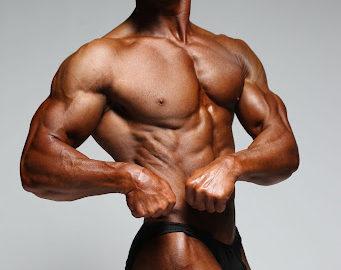
Q: Your explanations and methods in the e-book Ultimate Power-Density Mass Workout make total sense—and if Arnold used it, I’m in. [Positions of Flexion] also makes total sense, something I know Arnold used for his biceps, among other bodyparts. My question is, Can I use only the ending contracted-position exercise for each bodypart to get my Density quota? Say, for POF lats, can I train chins heavy, pullovers heavy and then use stiff-arm pulldowns with 5×10 in 10×10 style for Density?
A: What you’re proposing is something similar to Eric Broser’s Fiber Density/Fiber Saturation method or Hany Rambod’s FST-7. Rambod has you end with an isolation exercise for seven sets with 30 seconds between sets—that’s the 10×10 style, but using only seven sets. A lot of bodybuilders are going to that; however, after analyzing Arnold’s workouts, I think they’re missing a key mass-building component by not using Density on a compound move as well.
Arnold used Power plus Density on many of his big exercises up front. For example, on bench presses, his first chest exercise, he added weight over a number of sets as his reps dropped. When he was up in weight and down to six reps, he pulled off weight so that he could pound out a few 12-to-15-rep burnout sets. That way he continued to blast the mass of his pecs with endurance work, the other component of the fast-twitch 2A fibers. Remember, new research has found that the 2A fibers dominate in the biggest, freakiest bodybuilders.
Arnold was on to something, as the big exercises activate the most muscle fibers. If you use Density only on an isolation exercise, like stiff-arm pulldowns for lats, you’re achieving only limited fiber activation. That’s why Jonathan Lawson and I include a Density method for the big, compound ultimate exercises in our Power-Density Mass Workout at the beginning of each bodypart routine as well.
With that in mind, I suggest that your full Power-Density lat workout look something like the following (you can use different Density methods for each exercise, as you’ll see below):
Power-Midrange: Chins (pyramid) 3 x 10, 8, 6
Density-Midrange: Pulldowns* (10×10 style) 4 x 10
Power-Stretch: Pullovers 2 x 8-10
Density-Contracted: Stiff-arm
pulldowns (double drop) 1 x 9(7)(5)
* You’ll probably have to move to pulldowns, as you will have exhausted too many fibers on your Power-pyramid sets of chins to continue with chins on 10×10–style sets.
Now, for those who don’t have time for full-on POF routines for every bodpart, there’s the streamlined Basic Power-Density Mass Workout on pages 12 to 14 of the e-book that has you using only one compound ultimate exercise per bodypart. Nothing else: Power followed by Density—and I suggest you mix up your Density choices often. Do your Power pyramid on the first few work sets, ending with one of the following Density methods:
1) Lighter sets: Reduce the poundage and do two “burnout” sets of 12 to 15 reps—à la Arnold.
2) Double-drop set: Use a weight you can barely get nine reps with, then reduce it and immediately do a set of about six reps; reduce the weight again and blast out four or five final gut-busting reps. That’s three progressively lighter sets back to back—another Arnold favorite, especially on barbell curls; he called them strip sets.
3) 4×10 (in 10×10 style): Take a weight that you can use for 15 reps, but do only 10, rest 30 seconds, do 10 more, and so on until you complete four sets in about four minutes. The first set will be easy, but the last will be brutal—and the pump and feel will be unreal!
As I suggested, you can rotate Density tactics at every workout. The key is to use one after your Power pyramid on each exercise. And no matter which one you choose, each of your Basic Power-Density Mass Workouts will take only about 35 minutes to complete—one ultimate exercise per bodypart, Power first with a Density chaser. Now that’s efficiency of effort!
As Arnold proved—and as you’ll soon discover—Power plus Density equals muscle immensity.
Q: I’m using the Ultimate Fat-to-Muscle Workout [from the e-book of the same name] because I need to get ripped fast. It feels great, I’m seeing more muscularity, and people are commenting. The thing is, I’m really sold on 10×10. I just read The Ultimate 10×10 Mass Workout, and it sounds awesome. I tried it on arms, and mine blew up bigger than they’ve ever been. My question is, Can I add 10×10 to the Fat-to-Muscle Workout somehow?
A: I can tell you’re very motivated, and that’s more than half the battle in getting the ripped, eye-popping physique you’re striving for. You just have to be careful not to overtrain. That said, keep in mind that the 10×10 method is very taxing, which is why I usually recommend using it on only one ultimate exercise per bodypart, with no other work for that muscle.
Yes, I’ve discussed adding one set each of a stretch- and contracted-position move to complete the full-range Positions-of-Flexion chain, but that’s the limit. For example, barbell curls, midrange, 10×10; incline curls, stretch, 1 x 9; and concentration curls, contracted, 1 x 12. Even that may be pushing it for some trainees.
The Ultimate Fat-to-Muscle Workout uses another powerful technique: negative-accentuated sets. They’re designed to trigger excessive muscle trauma, which can ramp up fat burning after the workout. That’s why your muscularity has become more dramatic.
When you use NA, you raise the weight in one second and lower it in six for about seven reps. You get almost 50 seconds of tension time, a unique mass stimulus, but the real benefit of the slow lowering is that it increases muscle microtears. That ignites an intense repair process after the workout that can take days—so you’re burning fat 24/7 due to metabolic momentum. Research shows that fat fuels the muscle-repair process, a nice bonus.
You would no doubt overtrain quickly if you used both NA sets and 10×10; however, you can use 10×10 style but with fewer sets—for example 4×10. To work the shorter density sequence into your program, I suggest you end with it on the contracted-position exercise for each muscle—instead of doing the two higher-rep sets listed. For example, here’s how your new Fat-to-Muscle triceps program looks—the only change is on the last exercise:
Midrange: Lying extensions 2 x 9, 7
Midrange: Lying extensions (NA style) 1 x 6-8
Stretch: Overhead dumbbell extensions 1 x 7-9
Stretch: Overhead dumbbell
extensions (NA style) 1 x 6-8
Contracted: Pushdowns (10×10 style) 4 x 10
Remember, 10×10 style means using a lighter weight and doing 10 reps on each set with only 30 seconds between sets. So on pushdowns you start with a weight that you could get about 15 with but do only 10; then you rest 30 seconds and do 10 more, and so on until you complete four sets. The last set should be brutal, and you should not be able to get 10. If you do, add weight to that exercise at your next workout.
The pump and burn you get by doing 4×10 at the end will be unreal, and it’s the perfect growth grand finale for every bodypart. As I mentioned, that’s similar to Eric Broser’s Fiber Damage/Fiber Saturation training and Hany Rambod’s FST-7. Eric suggests that blowing up the muscle after traumatizing it—in this case with negative-accentuated sets and stretch overload—kick-starts anabolic acceleration and recuperation with an influx of nutrient-rich blood. I agree; now you can grow and get ripped simultaneously.
Q: What supplements do you suggest preworkout? I don’t want to shortchange my gains, so aside from a protein drink about an hour before, what else should I take?
A: If you’re looking for a preworkout supplement stack that can help your fat-to-muscle efforts, recent research points to conjugated linoleic acid as a good addition. Here’s what researcher Jerry Brainum reported:
“A new study compared three groups of weight trainees. [Int J Sports Nutr Exerc Metabol; 19:79-96. 2009.] Group 1 took six grams of conjugated linoleic acid, nine grams of creatine and 36 grams of whey; group 2 got the same amounts of creatine and whey but a placebo instead of CLA; group 3 got the same amount of whey but no CLA or creatine. Each group got that mix daily for five weeks while on an intense weight-training program. Results: Those taking all three supplements experienced more gains in bench press and leg press strength, along with lean tissue mass gains, than the other groups combined.”
More muscle gain means you’ll burn more calories, even at rest—but CLA has also been shown to help burn off bodyfat as well. Here’s what Jose Antonio, Ph.D., reported when creatine and CLA were used preworkout:
“Training improved all measurements of functional capacity and strength, with greater improvement for the CrM+CLA group in most measurements of muscular endurance, isokinetic-knee-extension strength, fat-free mass and lower-fat mass.”
More strength, muscle and fat loss. That’s why Jonathan Lawson, my training partner, and I are using about five grams of CLA, along with two caps of Creakic, MuscleTech’s advanced creatine pill, and two caps of a fat burner right before we train—Jonathan likes SAN’s Tight Xtreme because it contains yohimbine, a stubborn-fat uncoupler, while Steve prefers SAN’s Blaze Xtreme for its forskolin, which has been shown to increase testosterone as well as burn fat. For vasodilation, we both often take three caps of STS’s Nitrocarn GPLC 1500, as new studies show that glycine propionyl-L-carnitine produces a bigger pump than L-arginine.
That combo, along with including negative-accentuated sets and other fat-to-muscle techniques into our Power-Density workouts, has kicked up our results on all fronts—size, strength and leanness. IM




















You must be logged in to post a comment Login